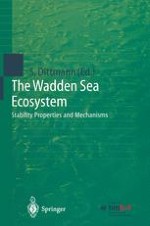1999 | OriginalPaper | Chapter
ELAWAT: Goals and Conceptual Framework
Authors : Sabine Dittmann, Volker Grimm
Published in: The Wadden Sea Ecosystem
Publisher: Springer Berlin Heidelberg
Included in: Professional Book Archive
Activate our intelligent search to find suitable subject content or patents.
Select sections of text to find matching patents with Artificial Intelligence. powered by
Select sections of text to find additional relevant content using AI-assisted search. powered by
The “Ecosystem Research Wadden Sea” consisted of four large joint projects carried out since 1989 on the southern North Sea coast of Germany. The projects had two major goals which were closely related. One was to develop a protection and management strategy for the Wadden Sea to preserve the diversity of its biota and landscape. This aspect also addressed the sustainable use of the Wadden Sea, i.e. a use of resources in such a way that no long-term decline of biological diversity results and the needs and aspirations of present and future generations are maintained. This goal was the task of two applied projects within the “Ecosystem Research Wadden Sea”, one in the state of Schleswig-Holstein and the other in Lower Saxony (Stock et al. 1996; Dittmann et al. 1997; Kellermann et al. 1997). The second goal was to achieve a fundamental understanding of this ecosystem. This was the task of two research projects, namely SWAP (“Sylter Wattenmeer Austausch Prozesse” = “Exchange processes of the Sylt Rømø-bight”), which was carried out in Schleswig-Holstein (Gätje & Reise 1998), and ELAWAT (“Elastizitat des Ökosystems Wattenmeer” = “Resilience of the Wadden Sea ecosystem”; Dittmann et al. 1997), carried out in Lower Saxony.
